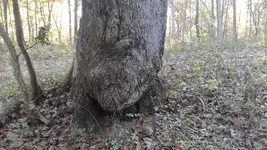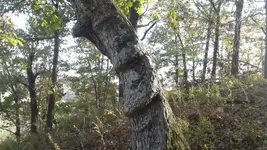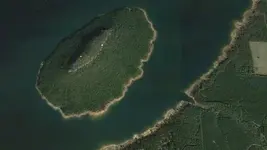Chadeaux
Gold Member
- Joined
- Sep 13, 2011
- Messages
- 5,512
- Reaction score
- 6,409
- Golden Thread
- 0
- Location
- Southeast Arkansas
- Detector(s) used
- Ace 250
- Primary Interest:
- Cache Hunting
I have trees like these near rivers. They didn't need to mark water this way. They are along trails, some very old trails. Anybody can find water when it is flowing in the canyons a few hundred feet away. The water theory on markers has always been hilarious to me and my friends. The same type markers people have been posting here for years that claim water marker, we have seen within a few hundred feet of a river that is massive, like you would have trouble swimming across. Perhaps these old explorers were totally blind. Also I have heard the markers being for old livestock trails.... makes sense , yeah right lol . Move a 10 -80 ton boulder with horses so you can know where to funnel your livestock. The boulders were placed there long before...
BTW did you notice how clear the area is around those tree markers so they stand out so well? They stick out like a sore thumb.
Some you will find near rivers and streams, yes. Here's is one of those by the Ouachita River:

The river is to the left side. The pointer on the right points at another tree that runs about 20 feet parallel to the ground before going skyward again. That tree marks a trail that runs from the Ouachita River to the Mississippi River. (Source: Me groundtruthing an 1838 map containing old Indian Trail). The place where the trail crosses the Mississippi River is a place bison were reported as crossing the Mississippi River in the 1800's.
The left side is marking water, but not where to find it. It "marks" (by pointing to it) a shallow crossing area on the river that was safe to pass. The crossing point leads to a path known to John Murrell (see the book "Ghosts of the Saline") and the trail may have been used by him to transit from the Sabine River in Louisiana (the westernmost point on the trail) to the Mississippi River near present day Eudora, AR.
John Murrell was known to have robbed at least one steam boat on the Mississippi River. No, he didn't mark this trail, but he did likely use it. You and I don't build highways, but we do use them to get from place to place. Those old trails were the highways of their day.
The trick is to know what you are being told by a tree, not whether the tree is bent or not. There are other reasons a trail tree might be near a present day stream ... perhaps the water run off has been redirected due to human activity sometime AFTER the tree was bent.
One more thing: Some trail trees definitely pointed to "living water" but I've seldom seen that type of tree posted in these forums, and never are those noted as being a water tree.
Last edited:









